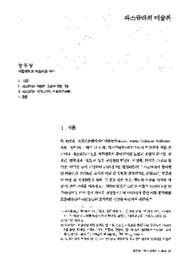

-
미리보기
서지정보
· 발행기관 : 한국미술이론학회
· 수록지 정보 : 미술이론과 현장 / 5호 / 43 ~ 80페이지
· 저자명 : 정주영
초록
PASKYULA was formed in September, 1923 through the union of artists involved in two art groups: Kim Ki-Jin, Kim Bok-Jin, Yeon Hak-Nyeon who had previously participated in the ToWolHoi, and Park Young-Hi, Lee Sang-Hwa, An Seok-Ju, former members of the BaeckJo. After its founding, the PASKYULA artists had been searching for the social function of art to reform the harsh reality of Minjung and the nation with criticism toward society as well as art world. Their art theory for MinJung could grow relatively ease in relation to changing social and political conditions in the early 1920s. In August, 1925, PASKYULA organized the Korea Artista Proletaria Federatio with the YeomGunSa, and laid the groundwork for Proletariat art movement which was regularized in the late 1920s.
From PASKYULA up to the early state of KAPF, the theory of art advocated by Kim Bok-Jin and An Seok-Ju could be summarized as "art for MinJung". At that time, widely ranging discourses on MinJung, however, was spawned in art theory, because many intellectuals`─`including artists and writers`─`begun to pay more attention to MinJung, who emerged as one of the social forces after the Samil Independent Movement. Sometimes, MinJung was construed as the target of enlightenment from a negative viewpoint. On the other hand, several intellectuals under the influence of individualism asserted that the discussion itself on MinJung exerted an evil influence on art. In contrast of these cases, the PASKYULA artists including Kim Bok-Jin, An Seok-Ju perceived that MinJung had the potential to change society, and regarded them as "a creator of genuine civilization and art". In the PASKYULA artist's writings, the concept of MinJung was often overlapped with the meaning of the Choson nation suffering under colony. Although their concept of MinJung was transformed gradually into the proletariat as they were under the strong influence of socialism, it did not change that they grasped the realities of the whole Choson Peninsula through the proletarian consciousness.
In the early state of PASKYULA, the methodology for social function of art was presented in a twofold manner. First of all, Kim Bok-Jin emphasized on the necessity of education to improve MinJung's way of life through art, and it was embodied by the organization of ToWol Art Workshop and public lecture. Also, he championed "the popularization of art", which was one of methods to distribute art to MinJung. According to the PASKYULA artists, art should be not art for art's sake but art for MinJung. That was why they advocated the convergence of art and MinJung's life. Especially Kim Bok-Jin affirmed a link between art and industry because he considered industry the field inextricably linked with MinJung's life. In this context, his idea could be read as the generalization and equalization within the framework of possession. Kim Bok-Jin thought that the social ramifications of capitalism deprived MinJung of their right to enjoy art, and emphasized the artist's social role to return the right to them. That is, the even distribution of art was mainly discussed than the contents of art in the half of 1920s.
By 1925, the contents of art itself became an issue in the PASKYULA art theory, and it was based in realism. Kim Bok-Jin and An Seok-Ju insisted that art should be reflection of real life. At that time, realism acquired the representation of MinJung and the nation's realities not realistic style. In fact, the various Western art styles including Futurism, Constructivism, Cubism etc. were exploited in the PASKYULA's visual images.
Western art, target of criticism on theory, was selectively adopted in the works which were produced by Kim Bok-Jin and An Seok-Ju. Kim Bok-Jin's MoonYeUnDong cover design was conceived of as the example in which Western art was adopted with it's ideology under the influence of MAVO, while Western art shown in An Seok-Ju's illustrations served as a decorative function in many cases. Especially, An Seok-Ju attempted the various styles of Western art simultaneously, which may be seen as representing that PASKYULA did not have a firm ideology for their style. Also, it can be read as showing his hasty zeal to overcome Western art rapidly. The wish to establish "art for MinJung" as soon as possible was accompanied with the will to jump over the all steps of Western art though it was superficial.
This aspiration of PASKYULA was expressed through the mass media, which had the potential for communicating to MinJung. At this point, there was a significant disparity between PASKYULA and another art groups in the first half of 1920s. However, the PASKYULA's method on the basis of the mass media could not but have a certain limitation because of the medium's properties. Nevertheless, PASKYULA?attempts may be considered to be valuable in sense that they expended the boundaries of Korean modern art into the commercial art questioning the matter of the distribution for art.영어초록
PASKYULA was formed in September, 1923 through the union of artists involved in two art groups: Kim Ki-Jin, Kim Bok-Jin, Yeon Hak-Nyeon who had previously participated in the ToWolHoi, and Park Young-Hi, Lee Sang-Hwa, An Seok-Ju, former members of the BaeckJo. After its founding, the PASKYULA artists had been searching for the social function of art to reform the harsh reality of Minjung and the nation with criticism toward society as well as art world. Their art theory for MinJung could grow relatively ease in relation to changing social and political conditions in the early 1920s. In August, 1925, PASKYULA organized the Korea Artista Proletaria Federatio with the YeomGunSa, and laid the groundwork for Proletariat art movement which was regularized in the late 1920s.
From PASKYULA up to the early state of KAPF, the theory of art advocated by Kim Bok-Jin and An Seok-Ju could be summarized as "art for MinJung". At that time, widely ranging discourses on MinJung, however, was spawned in art theory, because many intellectuals`─`including artists and writers`─`begun to pay more attention to MinJung, who emerged as one of the social forces after the Samil Independent Movement. Sometimes, MinJung was construed as the target of enlightenment from a negative viewpoint. On the other hand, several intellectuals under the influence of individualism asserted that the discussion itself on MinJung exerted an evil influence on art. In contrast of these cases, the PASKYULA artists including Kim Bok-Jin, An Seok-Ju perceived that MinJung had the potential to change society, and regarded them as "a creator of genuine civilization and art". In the PASKYULA artist's writings, the concept of MinJung was often overlapped with the meaning of the Choson nation suffering under colony. Although their concept of MinJung was transformed gradually into the proletariat as they were under the strong influence of socialism, it did not change that they grasped the realities of the whole Choson Peninsula through the proletarian consciousness.
In the early state of PASKYULA, the methodology for social function of art was presented in a twofold manner. First of all, Kim Bok-Jin emphasized on the necessity of education to improve MinJung's way of life through art, and it was embodied by the organization of ToWol Art Workshop and public lecture. Also, he championed "the popularization of art", which was one of methods to distribute art to MinJung. According to the PASKYULA artists, art should be not art for art's sake but art for MinJung. That was why they advocated the convergence of art and MinJung's life. Especially Kim Bok-Jin affirmed a link between art and industry because he considered industry the field inextricably linked with MinJung's life. In this context, his idea could be read as the generalization and equalization within the framework of possession. Kim Bok-Jin thought that the social ramifications of capitalism deprived MinJung of their right to enjoy art, and emphasized the artist's social role to return the right to them. That is, the even distribution of art was mainly discussed than the contents of art in the half of 1920s.
By 1925, the contents of art itself became an issue in the PASKYULA art theory, and it was based in realism. Kim Bok-Jin and An Seok-Ju insisted that art should be reflection of real life. At that time, realism acquired the representation of MinJung and the nation's realities not realistic style. In fact, the various Western art styles including Futurism, Constructivism, Cubism etc. were exploited in the PASKYULA's visual images.
Western art, target of criticism on theory, was selectively adopted in the works which were produced by Kim Bok-Jin and An Seok-Ju. Kim Bok-Jin's MoonYeUnDong cover design was conceived of as the example in which Western art was adopted with it's ideology under the influence of MAVO, while Western art shown in An Seok-Ju's illustrations served as a decorative function in many cases. Especially, An Seok-Ju attempted the various styles of Western art simultaneously, which may be seen as representing that PASKYULA did not have a firm ideology for their style. Also, it can be read as showing his hasty zeal to overcome Western art rapidly. The wish to establish "art for MinJung" as soon as possible was accompanied with the will to jump over the all steps of Western art though it was superficial.
This aspiration of PASKYULA was expressed through the mass media, which had the potential for communicating to MinJung. At this point, there was a significant disparity between PASKYULA and another art groups in the first half of 1920s. However, the PASKYULA's method on the basis of the mass media could not but have a certain limitation because of the medium's properties. Nevertheless, PASKYULA?attempts may be considered to be valuable in sense that they expended the boundaries of Korean modern art into the commercial art questioning the matter of the distribution for art.참고자료
· 없음태그
-
자주묻는질문의 답변을 확인해 주세요

꼭 알아주세요
-
자료의 정보 및 내용의 진실성에 대하여 해피캠퍼스는 보증하지 않으며, 해당 정보 및 게시물 저작권과 기타 법적 책임은 자료 등록자에게 있습니다.
자료 및 게시물 내용의 불법적 이용, 무단 전재∙배포는 금지되어 있습니다.
저작권침해, 명예훼손 등 분쟁 요소 발견 시 고객센터의 저작권침해 신고센터를 이용해 주시기 바랍니다. -
해피캠퍼스는 구매자와 판매자 모두가 만족하는 서비스가 되도록 노력하고 있으며, 아래의 4가지 자료환불 조건을 꼭 확인해주시기 바랍니다.
파일오류 중복자료 저작권 없음 설명과 실제 내용 불일치 파일의 다운로드가 제대로 되지 않거나 파일형식에 맞는 프로그램으로 정상 작동하지 않는 경우 다른 자료와 70% 이상 내용이 일치하는 경우 (중복임을 확인할 수 있는 근거 필요함) 인터넷의 다른 사이트, 연구기관, 학교, 서적 등의 자료를 도용한 경우 자료의 설명과 실제 자료의 내용이 일치하지 않는 경우
“미술이론과 현장”의 다른 논문도 확인해 보세요!
-
'가난한 연극, 가난한 미술‘ -그로토프트키 연극이론과 아르테 포베라 25 페이지
What a concept of theatricality in modern art became more controversial is through a review 'art and object-hood' on Michael Fried's minimal art, as having been already known broadly. As he had been c.. -
중국 문혁기 모범극(樣板戱)의 시각이미지-<紅燈記>의 혁명영웅상을 중심으로 19 페이지
Yangbanxi("model plays") symbolize the Cultural Revolution(1966~1976) in China. The Eight Model Revolutionary Works include five Chinese Modern Peking Operas, namely, Taking Tiger Mountain by Strategy..
찾으시던 자료가 아닌가요?
지금 보는 자료와 연관되어 있어요!
문서 초안을 생성해주는 EasyAI



